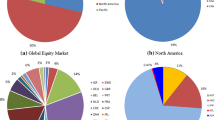Abstract
We analyze the cross-sectional relation between expected idiosyncratic volatility and stock returns. The expected idiosyncratic volatility is conditioned on macro-finance factors as well as traditional asset pricing factors. The macro-finance factors are constructed from a large set of macroeconomic and financial variables. Our results show that the negative relation between expected idiosyncratic volatility and stock returns reverses to a positive one when accounting for the macro-finance effects. Portfolio analysis shows that the positive relation is economically important. The relation between expected idiosyncratic volatility and returns is not affected by business cycle variations. The empirical results are highly robust.

Similar content being viewed by others
Notes
The Fama and French (1993) factors are freely available from Kenneth French’ web page.
Note, however, that Ludvigson and Ng (2007) use quarterly data, while our analysis is based on monthly data.
The macro-finance variables are transformed to be stationary by taking logs and first differences as appropriate.
Not all macro-finance variables are available for the entire sample period, but they are included as they become available.
The factors are not strongly correlated (average correlation coefficients are below 0.71), so there are not problems with multicollinearity.
References
Ang A, Hodrick RJ, Xing Y, Zhang X (2006) The crosssection of volatility and expected returns. J Finance 61:259–299
Ang A, Hodrick RJ, Xing Y, Zhang X (2009) High idiosyncratic volatility and low returns: international and further US evidence. J Financ Econ 91(1):1–23
Baker SR, Bloom N, Davis SJ (2016) Measuring economic policy uncertainty. Q J Econ 131(4):1593–1636
Bali T, Cakici N (2008) Idiosyncratic volatility and the cross section of expected returns. J Financ Quant Anal 43(1):29–58
Bali TG, Zhou H (2016) Risk, uncertainty, and expected returns. J Financ Quant Anal 51(3):707–735
Bali T, Cakici N, Whitelaw R (2011) Maxing out: stocks as lotteries and the cross-section of expected returns. J Financ Econ 99:427–446
Binder JJ, Merges MJ (2001) Stock market volatility and economic factors. Rev Quant Financ Acc 17(1):5–26
Boyer B, Mitton T, Vorlink K (2010) Expected idiosyncratic skewness. Rev Financ Stud 23:169–202
Brandt MW, Brav A, Graham JR, Kumar A (2010) The idiosyncratic volatility puzzle: time trend or speculative episodes. Rev Financ Stud 23:863–899
Cakici N, Topyan K, Wang C-J (2014) Cross-sectional return predictability in Taiwan stock exchange: an empirical investigation. Rev Pac Basin Financ Markets Policies 17(02):1450010
Campbell JY, Lettau M, Malkiel BG, Xu Y (2001) Have individual stocks become more volatile? An empirical exploration of idiosyncratic risk. J Finance 56:1–43
Carhart MM (1997) On persistence in mutual fund performance. J Finance 52(1):57–82
Chen Z, Petkova P (2012) Does idiosyncratic volatility proxy for risk exposure. Rev Financ Stud 25(9):2745–2787
Fama E, French K (1992) The cross-section of expected stock returns. Rev Finance 47(2):427–465
Fama E, French K (1993) Common risk factors in the returns on stocks and bonds. J Financ Econ 33:3–56
Fama E, MacBeth JD (1973) Risk, return, and equilibrium: empirical tests. J Polit Econ 71:607–636
Fink JD, Fink KE, He H (2012) Expected idiosyncratic volatility measures and expected returns. Financ Manag 41(3):519–553
Fu F (2009) Idiosyncratic risk and the cross-section of expected returns. J Financ Econ 91:24–37
Ghysels E, Plazzi A, Valkanov R (2013) The risk-return relationship and financial crises. Working Paper, UNC
Goetzmann W, Kumar A (2008) Equity portfolio diversification. Rev Finance 12(3):433–463
Goyal A, Welch I (2008) A comprehensive look at the empirical performance of equity premium prediction. Rev Financ Stud 21(4):1455–1508
Guo H, Kassa H, Ferguson MF (2014) On the relation between EGARCH idiosyncratic volatility and expected stock returns. J Financ Quant Anal 49:271–296
Herskovic B, Kelly B, Lustig H, Nieuwerburgh SV (2016) The common factor in idiosyncratic volatility: quantitative asset pricing implications. J Financ Econ 119:249–283
Huang W, Liu Q, Rhee S, Zhang L (2010) Return reversals, idiosyncratic volatility, and expected returns. Rev Financ Stud 23(1):147–168
Hur J, Luma CM (2017) Aggregate idiosyncratic volatility, dynamic aspects of loss aversion, and narrow framing. Rev Quant Financ Acc 49(2):407–433
Ludvigson SC, Ng S (2007) The empirical risk-return relation: a factor analysis approach. J Financ Econ 83(1):171–222
Lustig H, Verdelhan A (2012) Business cycle variation in the risk-return trade-off. J Monet Econ 59:35–49
Merton RC (1987) Presidential address: a simple model of capital market equilibrium with incomplete information. J Finance 42:483–510
Newey WK, West KD (1987) A simple, positive semi-definite, heteroskedasticity and autocorrelation consistent covariance matrix. Econometrica 55(3):703–708
Nyberg H (2012) Risk-return tradeoff in U.S. stock returns over the business cycle. J Financ Quant Anal 47(1):137–158
Pastor L, Stambaugh RF (2003) Liquidity risk and expected stock returns. J Polit Econ 111(3):642–685
Schwert GW (1989) Why does stock market volatility change over time? J Finance 44:1115–1153
Stambaugh RF, Yu J, Yuan Y (2015) Arbitrage asymmetry and the idiosyncratic volatility puzzle. J Finance 70:1903–1948
Vidal-García J, Vidal M, Nguyen DK (2016) Do liquidity and idiosyncratic risk matter? Evidence from the European mutual fund market. Rev Quant Financ Acc 47(2):213–247
Acknowledgements
The authors are grateful for helpful comments from an anonymous referee as well as from seminar participants at Rady School of Management, University of California San Diego and at the Conference on Computational and Financial Econometrics (CFE 2015) in London. Aslanidis acknowledges support from the Spanish Ministry of Science and Innovation project grant (Reference No. ECO2013-42884-P). Christiansen acknowledges support from CREATES funded by the Danish National Research Foundation (DNRF78) and from the Danish Council for Independent Research, Social Sciences (DFF – 4003-00022).
Author information
Authors and Affiliations
Corresponding author
Rights and permissions
About this article
Cite this article
Aslanidis, N., Christiansen, C., Lambertides, N. et al. Idiosyncratic volatility puzzle: influence of macro-finance factors. Rev Quant Finan Acc 52, 381–401 (2019). https://doi.org/10.1007/s11156-018-0713-x
Published:
Issue Date:
DOI: https://doi.org/10.1007/s11156-018-0713-x




